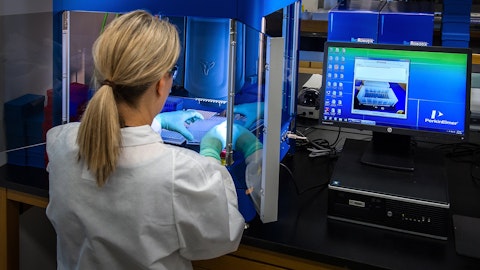Verona Pharma plc (NASDAQ:VRNA) Q4 2022 Earnings Call Transcript March 7, 2023
Operator: Welcome to Verona Pharma’s, Fourth Quarter and Full Year 2022 Financial Results and Operating Highlights Conference Call. At this time all participants are in a listen-only mode. Earlier this morning Verona Pharma issued a press release announcing its financial results for the three months and full year ended December 31, 2022. A copy can be found in the Investor Relations tab on the corporate website, www.veronapharma.com. Before we begin, I’d like to remind you that during today’s call, statements about the company’s future expectations, plans and prospects are forward-looking statements. These forward-looking statements are based on management’s current expectations. These statements are neither promises nor guarantees and involve known and unknown risks, uncertainties and other important factors that may cause our actual results, performance or achievements to be materially different from our expectations, expressed or implied by the forward-looking statements.
Any such forward-looking statements represent management’s estimates as of the date of this conference call. While the company may elect to update such forward-looking statements at some point in the future, it disclaims any obligations to do so, even if subsequent events cause its views to change. As a reminder, this call is being recorded and will remain available for 90 days. I’d now like to turn the call over to Dr. David Zaccardelli, Chief Executive Officer.
David Zaccardelli: Thank you, and welcome everyone to today’s call. With me today are Mark Hahn, our Chief Financial Officer; Dr. Kathy Rickard, our Chief Medical Officer; and Chris Martin, our Senior Vice President of Commercial. 2022 was a momentous year for Verona Pharma and first and foremost for the millions of patients suffering from COPD. Supported by the groundbreaking results from our Phase 3 ENHANCE trials we believe ensifentrine if approved has the potential to change the treatment paradigm for COPD. We are on track to submit a New Drug Application to the FDA in the second quarter of 2023. Over the past year we announced positive top line results from our Phase 3 enhanced trials evaluating nebulized ensifentrine for the maintenance treatment of COPD in moderate-to-severe COPD patients.

Photo by Tbel Abuseridze on Unsplash
Ensifentrine successfully met the primary endpoint in both ENHANCE-1 and ENHANCE-2, demonstrating statistically significant and clinically meaningful improvements in lung function, as well as remarkable reductions in rate and risk of exacerbations. The success of these trials advances us closer to providing ensifentrine to a patient population in urgent need of new effective treatment options. Additionally, this strong clinical data allowed us to significantly strengthen our financial position through an upsized $150 million equity offering in August and a $150 million non-dilutive debt financing facility with Oxford Finance in October, as well as through March 3rd, $58.6 million from ADS sales under our ATM program. With that said, let me take a step back and provide a brief review of our enhanced program.
As a reminder, the ENHANCE-1 and ENHANCE-2 trials were each designed to enroll approximately 800 moderate-to-severe symptomatic COPD subjects for a total of approximately 1600 subjects across sites primarily in the United States and Europe. The trials replicated measurements of efficacy and safety over 24 weeks, and ENHANCE-1 also evaluated longer-term safety in approximately 400 subjects over 48 weeks. Subjects received ensifentrine or placebo as either monotherapy or added on to a single long-acting bronchodilator with approximately 69% of subjects across ENHANCE-1 and 55% in ENHANCE-2 receiving either a LAMA long-acting muscarinic antagonist or LABA, long-acting beta agonist. Additionally, approximately 20% of subjects in ENHANCE-1 and 15% in ENHANCE-2 received inhaled corticosteroids with concomitant LAMA or LABA.
As previously announced, both the ENHANCE-1 and ENHANCE-2 trials successfully met primary and key secondary endpoints demonstrating statistically significant improvements in lung function. In addition, ensifentrine substantially improved symptoms and quality of life, as well as reducing the rate and risk of COPD exacerbations in both trials, and was well tolerated over 24 and 48 weeks. Importantly, pooled exacerbation data from ENHANCE-1 and ENHANCE-2 demonstrated that ensifentrine treatment resulted in a statistically significant 40% reduction in the rate of COPD exacerbations compared with placebo over 24 weeks. Further, ensifentrine significantly decreased the risk of an exacerbation as measured by time to first exacerbation when compared with placebo by 41%.
Based on the study population we believe this magnitude of reduction in exacerbation rate and risk is unprecedented in Phase 3 COPD trials and further validates the importance of ensifentrine’s novel mechanism delivering non-steroidal anti-inflammatory activity in addition to bronchodilation for the treatment of patients with COPD. I’d also like to reiterate the consistency of the positive results between ENHANCE-1 and ENHANCE-2 trials. The totality of the data from both studies coupled with favorable safety profile of ensifentrine support our belief that ensifentrine will change the treatment paradigm for COPD. With this positive data in hand, we plan to submit an NDA to the FDA in the second quarter of this year. In parallel, our pre-commercial commercialization efforts and U.S. launch activities are proceeding as planned.
Following our strong ENHANCE-2 two data in August, we begin filling key leadership positions across commercial, HR, IT, and finance. We are accelerating our efforts as we prepare for NDA submission and beyond, and we are confident that we will be well positioned for a potential U.S. launch of ensifentrine in 2024.
Nuance Pharma: Currently, more than 380 million patients suffer from COPD worldwide, and it is the third leading cause of death. Despite the availability of existing COPD treatments, approximately 50% of patients experience symptoms for more than 24 days per month, and physicians require new and effective COPD therapies to provide relief to their patients. With its novel mechanism of action as a selective PDE3 and PDE4 inhibitor, we believe ensifentrine if approved, will be groundbreaking in the field of COPD management. We expect 2023 to be another pivotal year for Verona as we advance towards our mission of delivering ensifentrine to patients with COPD. I will now turn the call over to Mark to review our financial results for 2022.
Mark Hahn: Thank you, Dave. Good morning. We ended 2022 with $227.8 million in cash and equivalents. Starting in January, we ran the ATM program through last Friday, and during that time, we raised net proceeds of approximately $56.9 million. After giving effect to the proceeds from the ATM facility, our pro forma cash and equivalents at December 31, 2022 was $284.7 million. Between the cash currently on hand, the expected receipts from the UK tax credit program, and funding expected to be available under the $150 million Oxford loan facility, we believe our cash runway will extend through at least the end of 2025, including the planned commercial launch of ensifentrine in the United States. For the year ended December 31, 2022, the net loss after tax was $68.7 million compared to a net loss after tax of $55.6 million for the prior year.
The loss in 2022 was higher, primarily due to $40 million of non-recurring revenue related to the Nuance agreement, which more than offset the higher R&D spend in 2021. This represents a loss of $13 per ordinary share, or $1.04 per ADS for the year, compared to a loss of $0.12 per ordinary share or $0.96 per ADS in 2021. Research and development costs were $49.3 million for the year ended December 31, 2022 compared to $79.4 million reported for the year 2021. The decrease was primarily due to lower clinical trial and other development costs of $27.9 million resulting from the enhanced studies nearing completion in 2022 and a $4.2 million decrease in share based compensation charges. Selling, general and administrative expenses were $26.6 million for the year end of December 31, 2022 compared to $33.9 million reported for the prior year.
The decrease of $7.3 million was primarily due to lower share based compensation charges. The UK R&D tax credit for 2022 was $9.6 million compared to a credit of $15.6 million for the year ended December 31, 2021. The decrease of $6 million is in line with our lower qualifying R&D expenditure incurred with the enhanced program in 2022. I’ll now turn the call back over to the operator for the Q&A.
See also 14 Best American Dividend Stocks to Buy Now and 10 Mad Money Stock Picks This Week.
Q&A Session
Follow Verona Pharma Plc (NASDAQ:VRNA)
Follow Verona Pharma Plc (NASDAQ:VRNA)
Operator: We will now begin the question and answers session. Our first question will come from Andreas Argyrides with Wedbush Securities. You may now go ahead.
Andreas Argyrides: Good morning, and thanks for taking our question. Just one from us here. So I see you gentlemen have guided the top line results from the Phase 3 study of Dupixent in moderate-to-severe COPD type 2 inflammation later this month. The KOLs we’ve spoken with have about a 20% reduction in exacerbations as being clinically meaningful, which is well below the 40% ensifentrine showed. So curious to get your thoughts on the readout and what impact positive data may have on the commercial landscape and ensifentrine’s positioning and exacerbations. Thanks.
David Zaccardelli: All right. Good morning, Andreas. Thanks for the question. I’m going to ask Kathy to give her perspective as a pulmonologist on Dupixent and its impact. You know, overall I think that we’re intrigued by the study, but I think we need to keep in mind that the patient population is much more limited than that we addressed with ensifentrine and so we don’t really see a big impact. But Kathy, you may want to comment on it?
Kathleen Rickard: Sure. So as Dave said, the population would be different because this would be a much smaller population of COPD patients. In general they are looking for patients who have high eosinophils and so forth, and without actually having a protocol in front of you, I can’t tell you all the differences. But generally they’re looking at a niche area to affect patients for that. And certainly 20% might be good in that population if, since they’re usually taking a whole bunch of other medications also. But what’s so remarkable about ensifentrine is that we have about a 40% in a total COPD population, so it doesn’t matter whether you have high eosinophils or not, or whether you have chronic bronchitis or not, whether you’re on inhaled steroids or not, we see this remarkable decrease in exaggerations in a general COPD population. So I think that’s what makes the difference between ensifentrine and looking at a compound like Dupixent.
Andreas Argyrides: And would, just a quick followup there, would positive data I’m assuming Dupixent maybe on the market, would that impact any pricing, especially given the benefit that ensifentrine has shown in exacerbations compared to Dupixent?
David Zaccardelli: Hello, Chris, you want to comment in general on where we are with pricing?
Christopher Martin: Yes, I can do that. Andreas. I think when we think about pricing with Mc Entin, we’ve, we’ve used the current nebulized products as a kind of a baseline floor for ensifentrine, we view the current nebulized products of kind of a baseline core for ensifentrine. Those products by the time we launch will be somewhere around $1,400 a month. One of the things that we realized, and you just mentioned there, is the results on exacerbations are very impactful, not only to the physician community, but to the payer community. And when we’ve talked to payers today within Medicare Part-D, Medicare Advantage, they expect ensifentrine to be priced at a premium versus those current products. I think some of the other dynamics that we have in play as we think about pricing are the impact of the Inflation Reduction Act and that legislation on how we might price ensifentrine going into the market.
But the important thing here is that the profile of ensifentrine, which provides bronchodilation, improvements in symptoms, and the marketable market results on exacerbation, provide a lot of price flexibility for us as we think about what that value would be as we get to launch. So, I think we feel very confident that ensifentrine’s value is great within the marketplace, and we also feel like from a payer perspective, the rep receptivity to pricing ensifentrine at a premium versus the current products is a very positive reception as well.
Andreas Argyrides: Okay great. Congrats on all the progress. Thanks.
David Zaccardelli: Thanks, Andreas.
Operator: Our next question will come from Joon Lee with Truist Securities. You may now go ahead.




